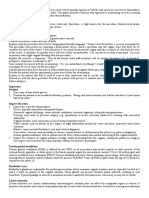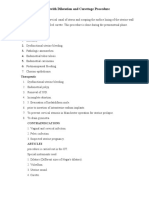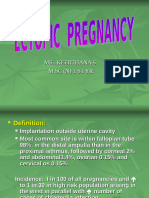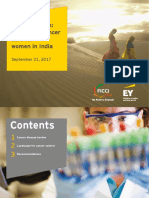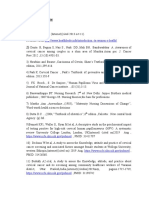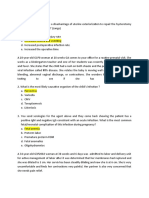0 ratings0% found this document useful (0 votes)
264 viewsNCM 102: Gynecology Nursing Management
NCM 102: Gynecology Nursing Management
Uploaded by
dubhieThis document discusses various gynecological diagnostic tests, procedures, and disorders including:
1. Diagnostic tests for the reproductive system such as serum laboratory studies, pelvic examinations, laparoscopy, culdoscopy, and cultures.
2. Procedures like cervical biopsy, conization, Schiller's test, ultrasonography, D&C, mammography, and thermography.
3. Inflammatory disorders including pelvic inflammatory disease and endometriosis and their symptoms, causes, treatments, and nursing considerations.
4. Menstrual disorders like dysmenorrhea and its management.
5. Benign breast conditions such as fibrocystic breast disease.
Copyright:
Attribution Non-Commercial (BY-NC)
Available Formats
Download as DOCX, PDF, TXT or read online from Scribd
NCM 102: Gynecology Nursing Management
NCM 102: Gynecology Nursing Management
Uploaded by
dubhie0 ratings0% found this document useful (0 votes)
264 views7 pagesThis document discusses various gynecological diagnostic tests, procedures, and disorders including:
1. Diagnostic tests for the reproductive system such as serum laboratory studies, pelvic examinations, laparoscopy, culdoscopy, and cultures.
2. Procedures like cervical biopsy, conization, Schiller's test, ultrasonography, D&C, mammography, and thermography.
3. Inflammatory disorders including pelvic inflammatory disease and endometriosis and their symptoms, causes, treatments, and nursing considerations.
4. Menstrual disorders like dysmenorrhea and its management.
5. Benign breast conditions such as fibrocystic breast disease.
Original Title
Reproductive System
Copyright
© Attribution Non-Commercial (BY-NC)
Available Formats
DOCX, PDF, TXT or read online from Scribd
Share this document
Did you find this document useful?
Is this content inappropriate?
This document discusses various gynecological diagnostic tests, procedures, and disorders including:
1. Diagnostic tests for the reproductive system such as serum laboratory studies, pelvic examinations, laparoscopy, culdoscopy, and cultures.
2. Procedures like cervical biopsy, conization, Schiller's test, ultrasonography, D&C, mammography, and thermography.
3. Inflammatory disorders including pelvic inflammatory disease and endometriosis and their symptoms, causes, treatments, and nursing considerations.
4. Menstrual disorders like dysmenorrhea and its management.
5. Benign breast conditions such as fibrocystic breast disease.
Copyright:
Attribution Non-Commercial (BY-NC)
Available Formats
Download as DOCX, PDF, TXT or read online from Scribd
Download as docx, pdf, or txt
0 ratings0% found this document useful (0 votes)
264 views7 pagesNCM 102: Gynecology Nursing Management
NCM 102: Gynecology Nursing Management
Uploaded by
dubhieThis document discusses various gynecological diagnostic tests, procedures, and disorders including:
1. Diagnostic tests for the reproductive system such as serum laboratory studies, pelvic examinations, laparoscopy, culdoscopy, and cultures.
2. Procedures like cervical biopsy, conization, Schiller's test, ultrasonography, D&C, mammography, and thermography.
3. Inflammatory disorders including pelvic inflammatory disease and endometriosis and their symptoms, causes, treatments, and nursing considerations.
4. Menstrual disorders like dysmenorrhea and its management.
5. Benign breast conditions such as fibrocystic breast disease.
Copyright:
Attribution Non-Commercial (BY-NC)
Available Formats
Download as DOCX, PDF, TXT or read online from Scribd
Download as docx, pdf, or txt
You are on page 1of 7
NCM 102: GYNECOLOGY NURSING MANAGEMENT
REPRODUCTIVE SYSTEM Instruct patient to abstain from
intercourse, douching, and using
FEMALE tampons until advised by physician
5. Cervical biopsy examination: removal of
DIAGNOSTIC TESTS tissue to examine for presence of
malignancy
1. Serum laboratory studies After procedure, advice patient to rest
Luteinizing hormone (LH): and avoid strenuous activity for 24
i. Diminished levels may relate to hours
prolonged, heavy menses Leave packing in place until physician
ii. Elevated levels may result in short, permits removal (usually 12 to 24 hours)
scanty menses Monitor for vaginal bleeding
Follicle-stimulating hormone (FSH) Instruct patient to abstain from
i. Diminished level may relate to intercourse,douching, and use of
bleeding between cycles tampons until advised by physician
ii. Elevated levels may result in Explained that a malodorous discharge
excessive uterine bleeding that may last three weeks will occur,
Thyroid function tests daily bath should help control this
i. Diminished thyroid hormone discharge
secretion may result in bleeding 6. Conization
between cycles, irregular menses, or Removal of cone-shaped tissue of the
absence of menstrual flow cervix for analysis of cancerous cells
Adrenal function tests Indicated for removal of diseased
i. Elevated or decreased production of cervical tissue
adrenal cortex hormone secretion Nursing interventions
may result in a amenorrhea i. Maintained packing 12 to 24 hours
2. Pelvic examination: to inspect and assess ii. Monitor for bleeding
the external genitalia, perineal and anal iii. Instruct patient to abstain from
areas, introitus, vaginal tract & cervix intercourse, douching, and using
Have patient empty bladder tampons until advised by physician
Please patient in lithotomy position 7. Schiller’s test
Flex and abduct patient’s thighs Application of a dye to the cervix to aid
Please patients feet in stirrups in detecting cancerous cells
Extends patients buttocks slightly Normal vaginal cells will stain a deep
beyond the edge of the examining table brown
3. Laparoscopy: visualization of the pelvic Abnormal cells will not absorb the dye
structures with a lighted laparoscope Nursing intervention: recommend to
inserted through the abdominal wall patient that a perineal pad be used to
4. Culdoscopy: visualization of the ovaries, protect clothes from stain
fallopian tubes, and fallopian tubes, and 8. Ultrasonography
uterus with a lighted instrument inserted A sound frequency that reflects an
through the vaginal tract image of the pelvic structures
After procedure, position patient on An aid in confirming ovarian and uterine
abdomen to expel air tumors
Monitor for vaginal bleeding 9. Culture and sensitivity
The culture of a specimen and exudate
suspected of infection
PREPARED BY: TJM
NCM 102: GYNECOLOGY NURSING MANAGEMENT
The sensitivity of an antibiotic to the
microorganism INFLAMMATORY DISORDERS
10. Dilatation & curettage (D&C)
A diagnostic and therapeutic procedure Pelvic Inflammatory Disease
The cervix is dilated to scrape the lining
of the uterine cavity with a curet. An inflammatory process involving
Nursing intervention pathogenic invasion of the fallopian tubes
After procedure, provide sterile perineal or ovaries or both, as well as any vascular or
pads and record amount of drainage supporting structures within the pelvis,
Encourage avoiding to prevent urinary except the uterus.
retention Risk factors include multiple sexual
Instruct patient to abstain from partners, frequent intercourse, IUDs, and
intercourse, douching, and using childbirth.
tampons until advised by physician Symptoms include low-grade fever, pelvic
11. Mammography: an x-ray examination of the pain, abdominal pain, a “bearing down
breasts to detect tumors; screening test is backache, foul-smelling vaginal discharge,
dunned yearly for women over 40 years of nausea, etc.
age Future infertility may develop as
12. Thermography: infrared photography used complications.
to detect breast tumors Diagnostic tests and method: C&S, CBC,
13. Xerography: an x-ray examination of the pelvic examination, laparoscopy
breasts and skin that provides good Treatment: antibiotic therapy, analgesics
definition of the tissue Nursing interventions
Provide nonjudgmental, accepting
MENSTRUAL DISORDER attitude
Place patients in semi-Fowler’s position
Dysmenorrhea: Painful menstruation to provide dependent pelvic drainage
Apply heat to abdominal area if ordered
Cause: uterine spasms cause cramping of the lower to improve circulation and provide
abdomen comfort
Signs and Symptoms Endometriosis
Subjective: Headache, backache, abdominal
pain, chills, nausea The growth of endometrial tissue, the
Objective: Fever, vomiting normal lining of the uterus, outside of the
uterus within the pelvic cavity.
Treatment Most often occurs in women over 30 with
Analgesics, such as NSAIDs familial history.
Local application of heat One cause of female infertility.
Pelvic exercises Signs and symptoms
Subjective
Nursing Intervention: Discomforts of pelvic area before
Instruct patient on avoidance of fatigue and menses, becoming worse during
overexertion during menstrual period. menstrual flow, and diminishing as
Instruct patient on ingestion of warm flow ceases .
beverages before onset of pain to prevent Dyspareunia
attack Fatigue
PREPARED BY: TJM
NCM 102: GYNECOLOGY NURSING MANAGEMENT
Objective: infertility Condition occurs during reproductive years
Diagnostic tests and methods and disappears with menopause
Laparoscopy culdoscopy A benign condition affecting 25% of women
Treatment over 30 years of age
Hormonal therapy to suppress ovulation Signs and symptoms
Surgical intervention: hysterectomy, Subjective: breast tenderness and pain
oophorectomy, or salpingectomy Objective: small, round, smooth nodules
Nursing interventions Diagnostic tests and methods
Provide emotional support . Mammography, thermomastography,
If patient is young, advised not to delay xerography
having a family because of risk of Treatment: conservative
sterility . Aspiration
Explain that hormonal drugs may cause Biopsy examination to rule out
pseudo pregnancy and irregular malignancy
bleeding Nursing intervention
If patient is middle-aged, advise her that Explain importance of monthly breast
menopause may stop progression of self-examination
condition Encourage patient to seek medical
Follow general post operative nursing evaluation if nodule forms, because
actions, if the patient undergoes cystic disease may interfere with early
surgical procedure diagnosis of breast malignancy
Observe for vaginal hemorrhage,
malodorous vaginal discharge, or MALIGNANT NEOPLASMS
vaginal discharge, other than
serosanguineous discharge Breast Cancer
Observe for year-end retention,
burning, frequency, or urgency to Second major cause of cancer death among
void women. Statistics indicate that 1 in 10 will
Listen to renewed bowel sounds develop cancer sometime during her life.
Provide patient teaching on discharge The key to cure is early detection by
Heavy lifting, prolonged standing, physical examination, mammography, and
walking, and sitting are breast self-examination.
contraindicated Signs and symptoms
Sexual intercourse should be Subjective: nontender nodule
avoided until approved by physician Objective:
Enlarged axillary nodes
Nipple retraction or elevation
Skin dimpling
Nipple discharge
Diagnostic tests and methods
Mammography, thermography,
BENIGN NEOPLASM xerography, breast biopsy examination
Treatment
Fibrocystic Breast Disease(FBD) Lumpectomy: removal of the lump and
partial breast tissue; indicated for early
Cause is unknown; possible hormonal detection
imbalance Mastectomy
PREPARED BY: TJM
NCM 102: GYNECOLOGY NURSING MANAGEMENT
Simple mastectomy: removal of Measure upper arm and
breast forearm, twice daily, to monitor
Modified radical mastectomy: edema
removal of breast, pectoralis minor, Encourage exercises of the
and some of an adjacent lymph affected arm when approved by
nodes a physician; avoid abduction
Radical mastectomy: removal of the Patient teaching on discharge
breast, pectoral muscles, pectoral Exercise to tolerance
fascia, and nodes Sleep with arm elevated
Oophorectomy, adrenalectomy, Elevated arm several times daily
hypophysectomy to remove source of Avoid injections, vaccinations, IV,
estrogen and the hormones that and taking blood pressure, in
stimulate the breast tissue affected arm
Radiation therapy to destroy malignant Cervical Cancer
tissue
Chemotherapeutic agents to shrink, The most preventable gynecological cancer,
retard, and destroy cancer growth it is detected by Papanicolaou (Pap) smear.
Corticosteroids, antigens, and anti- An abnormal Pap smear shows dysplasia, a
estrogens to alter cancer that is change in the size and shape of the cervical
dependent on hormonal environment cells.
Nursing intervention Sexual habits constitute a major factor in
Provide atmosphere of acceptance, the development of cancer of the cervix,
frequent patient contact, and with sexually transmitted disease being a
encouragement in illness particularly significant factor.
adjustment Five year survival rate is 69%.
Encourage grooming activities Signs and symptoms
Arrange attractive environment Subjective
If the patient is receiving radiation Asymptomatic in early stage
or chemotherapy, explain and assist Menstrual disturbances
with potential site effects Postmenopausal bleeding
If the patient has undergone surgical Bleeding after intercourse
intervention, follow post operative Watery discharge
nursing actions Objective: suspicious Pap test result
Elevate affected arm above level Diagnostic tests and methods
of right atrium to prevent edema Pap smear
Drawing blood or administering Cervical biopsy examination
parenteral fluids or taking blood Colposcopy
pressure on affected arm is Schiller’s test
contraindicated Conization
Monitor dressing for Treatment
hemorrhage, observed back for Panhysterectomy
pooling of blood Radiation in advance case
Empty Hemovac and measure Chemotherapy
drainage every 8 hours Nursing interventions
Assess circulatory status of Reassure the patient and family that
affected limb adjustment illness can be slow
PREPARED BY: TJM
NCM 102: GYNECOLOGY NURSING MANAGEMENT
Acknowledge that the patient must Panhysterectomy, oophorectomy,
adapt to illness, according to her age, salpingectomy
developmental stage, and past life Chemotherapy
experiences Radiation
If patient is to receive an internal Nursing interventions: see cancer of the
radium implant: cervix
Provide isolation
Instruct a patient to maintain supine
or side-lying position
Explaine to the patient and visitors
that the amount of time spent with MALE
patients will be limited to avoid
overexposure to radiation Prostatitis
Provide high-protein, low residue
diet to avoid straining of bowels An inflammation of the prostate which is a
Maintain high fluid intake: 2000 to common complication of urethritis caused
3000 mL daily by chlamydia or gonorrhea.
Insert Foley catheter to prevent Symptoms include perineal pain,
bladder distention fever,dysuria, and urethral discharge.
Administer antiemetics as ordered Nursing Interventions:
If the patient undergo surgery, followed Encourage bed rest
general post operative nursing actions Monitor VS, esp. temp for fever
Monitor I & O
Endometrial Cancer Assess pain
Sitz bath – provide comfort
Postmenopausal women are at greatest Provide ice pack to scrotum to decrease
risk, especially if they have taken estrogen swelling
therapy for more than five years. Elevate or provide scrotal support
Cancer of the endometrium does not Medical Interventions:
usually produce symptoms until it becomes Analgesic
relatively advanced. Antibiotic
The five-year survival rate for endometrial Procaine = anesthetic
cancer is 84%. Stool softeners
Signs and symptoms Digital massage – rectally – release
Subjective infected fluid
Postmenopausal bleeding
Bleeding between cycles Benign Prostatic Hyperplasia
Bleeding after intercourse Slow enlargement of the prostate
Watery vaginal discharge Men over 40 year (prostate gland
Objective enlargement begins)
Uterine enlargement On the latent phase it will constrict the
Suspicious Pap test results urethra which interferes in urination
Diagnostic tests and methods: D & C, tissue
biopsy examination SIGNS/SYMPTOMS
Treatment SUBJECTIVE
Surgical intervention Frequency
Urgency
PREPARED BY: TJM
NCM 102: GYNECOLOGY NURSING MANAGEMENT
Difficulty initiating stream Suprapubic resection – lower abdomen
Incomplete emptying of the bladder – incision through the bladder –
after urination urethrotomy
OBJECTIVE Retropubic – lower abdomen – does not
Nocturia go through the bladder
Hematuria
Weak stream Pharmacologic Management
Urinary retention
Biopsy reveals hyperplasia Alpha blockers – relax the smooth muscles
Rectal Examination along urinary tract (Hytrin, Cardura) – p.
852
Diagnosis: S/E: dizziness – orthostatic hypotension
PSA – prostate specific antigen = high Belladonna & Opium suppository – reduce
Rectal examination – most reliable post-op bladder spasm
Ultrasound Narcotic analgesic – relieve p-op pain –
Cystoscopy – visualization of bladder Vicodin, Morphine, Codeine – S/E
IVP – Intravenous Pyelography – inject a constipation
dye through vein – visualize bladder, Proscar – androgen hormone inhibitor –
ureters, kidney – allergic to shellfish or may arrest prostate enlargement
iodine?
BUN – blood, urea, nitrogen – urine, blood – Nursing. Interventions
increase Increased fluids – monitor I & O
Serum creatinine – Increased Maintain gravity drainage of F/C
Monitor blood clots and color = bright red =
Management bleeding
Keep irrigation flowing, note clots
Transurethral Resection of the Prostate Monitor VS – pain level, temp – orally, NOT
Continuous irrigation = reduce or prevent rectal
clot formation = clogs urethra = urinary Avoid straining, provide stool softeners
retention = kidney damage Teach deep breathing, relaxation technique
Monitor I & O Avoid straining
3-way f/c Observe bladder distention & spasms = ask
Monitor fluid overload=water for antispasmodic – stops spasms = pain,
intoxication increase blood clots
Edema, mental status = agitation,
lethargy Prostate Cancer
Monitor for distention – bladder
Stent The second leading cause of cancer deaths
Balloon in men.
Surgical Risk factors include: advancing age (over
TULIP – Transurethal Ultrasound-guided 55); first-degree relative with prostate
Laser-induced prostatectomy cancer; African-American heritage; high
Less invasive level of serum testosterone.
PROSTATECTOMY Five-year survival rate is 89%.
Perineal prostectomy – incision through
perineum SIGNS AND SYMPTOMS
PREPARED BY: TJM
NCM 102: GYNECOLOGY NURSING MANAGEMENT
Early tumor – no symptoms Control pain – terminally ill = hospice,
Subjective palliative care
Back pain, same symptoms as BPH –
hesitancy, decrease pressure, INFERTILITY
frequency, dysuria, urinary retention
Objective Causes of infertility in males include
Symptoms from metastasis varicoceles, cryptorchidism, impaired
Lumps – inguinal sperm, insufficient number of sperm, and
Enlarged lymph nodes hormonal imbalance.
Blockage of urethra, and rectal Tight-fitting underwear and use of hot tubs
dysfunction or saunas may decrease the sperm count.
In female, may be related to anatomic or
Diagnostic Tests endocrine problems.
Diagnostic tests may include:
Rectal examination Endometrial biopsy to detect tissue
PSA- prostate specific antigen – elevated responses during both phases of
Prostatic smear – abnormal cells, dysplasia menstrual cycle.
Acid phosphatase – prostate – 100x higher Endocrine imbalance testing.
than normal – PAP – prostatic acid Laparoscopy to discover conditions such
phosphatase as endometriosis, adhesions, or scar
Serum alkaline phosphatase – increased if tissue.
bone metastasis Treatment includes counseling,
Bone scan – metastasis medications, circulatory aids, and surgery.
MRI, CT scan
Treatment
Radiation, chemo, surgical removal
Radical perineal prostatectomy –
removal of prostate, surrounding
tissues, lymph nodes – inguinal area
Urethra is anastomosed to the bladder
Urostomy
Bilateral orchiectomy (removal of testes)
TURP
Estrogen therapy – inhibits serum
testosterone = contradicts
Agonists of LH – estrogen
Radioactive seed implant – rectally
Nursing Interventions:
BPH interventions
Be supportive – expect feminization, more
emotional, educate
Gynecomastia – enlargement of the breast
PREPARED BY: TJM
You might also like
- Validation Data AmpFire HPV 16 18 HR According To Meijer Criteria v3Document9 pagesValidation Data AmpFire HPV 16 18 HR According To Meijer Criteria v3AntarToumaNo ratings yet
- Nursing Diagnosis of Prostate CancerDocument3 pagesNursing Diagnosis of Prostate CancerSyafiqAzizi100% (1)
- NCM 112 Lecture Module 4 Cellular AberrationDocument16 pagesNCM 112 Lecture Module 4 Cellular AberrationMeryville Jacildo100% (2)
- Associate Professor:Ivan Bonet. Obstetric and Gynecology Associate Professor:Ivan Bonet. Obstetric and GynecologyDocument31 pagesAssociate Professor:Ivan Bonet. Obstetric and Gynecology Associate Professor:Ivan Bonet. Obstetric and Gynecologyivan0% (1)
- MCN QuestionsDocument9 pagesMCN QuestionsLianne BuensucesoNo ratings yet
- HYSTEROSDocument3 pagesHYSTEROSDk Bhai KaipengNo ratings yet
- HSGDocument27 pagesHSGNauman JavedNo ratings yet
- Management of Uterine InversionDocument36 pagesManagement of Uterine Inversionogundapo100% (2)
- POSTPARTUM-HEMORRHAGE LecDocument13 pagesPOSTPARTUM-HEMORRHAGE LecMay MayNo ratings yet
- GynecologyDocument119 pagesGynecologyJohn PaulNo ratings yet
- Obstetric OperationDocument6 pagesObstetric Operationds622915No ratings yet
- Dilatation and Curettage: Presented By: Pooja Rauniyar Roll No: 31 B.Sc. Nursing 3 Year 14 BatchDocument29 pagesDilatation and Curettage: Presented By: Pooja Rauniyar Roll No: 31 B.Sc. Nursing 3 Year 14 Batchrauniyarpooja25No ratings yet
- HysterectomyDocument8 pagesHysterectomykaveeshaNo ratings yet
- Adobe Scan May 08, 2024Document11 pagesAdobe Scan May 08, 2024Angela SalacutNo ratings yet
- Gynaecology Surgery PresentationDocument117 pagesGynaecology Surgery Presentationnorhafizahstoh89No ratings yet
- Assisting With Gynecological ProceduresDocument12 pagesAssisting With Gynecological ProceduresVismayamaliekalNo ratings yet
- Lect Unit II AbortionDocument23 pagesLect Unit II AbortionAlmasNo ratings yet
- Abruptio PlacentaDocument12 pagesAbruptio PlacentaAiley DumpNo ratings yet
- 3099 5583 1 PBDocument5 pages3099 5583 1 PBThanh Sang NguyễnNo ratings yet
- 8 Uterine Prolapse by HINADocument34 pages8 Uterine Prolapse by HINAmasalakhan555No ratings yet
- Amniocentesis ProcedureDocument6 pagesAmniocentesis Proceduresweta50% (2)
- Hirsch SprungDocument16 pagesHirsch SprungjessyNo ratings yet
- Cervical ScreeningDocument3 pagesCervical ScreeningShum Wing Hei Joanne100% (1)
- Subinvolution of The UterusDocument5 pagesSubinvolution of The UterusJanica Rose Maloloy-onNo ratings yet
- Dilatation and Curettage ProcedureDocument3 pagesDilatation and Curettage Proceduresagi muNo ratings yet
- Medical Management Include Drug Therapy: Hydatidiform MoleDocument2 pagesMedical Management Include Drug Therapy: Hydatidiform MoleMaye ArugayNo ratings yet
- Lower Segment Cesarean SectionDocument17 pagesLower Segment Cesarean SectionsnehaNo ratings yet
- ENDOMETRIOMADocument8 pagesENDOMETRIOMAJennine ReyesNo ratings yet
- 10-Advance Nursing Management of Reproductive DiseasesDocument87 pages10-Advance Nursing Management of Reproductive Diseasesabdul satar100% (1)
- Assisting With Dilatation and Curettage ProcedureDocument3 pagesAssisting With Dilatation and Curettage ProceduremanjuNo ratings yet
- EndometriosisDocument31 pagesEndometriosisOPIO SAMNo ratings yet
- Total Abdominal Hysterectomy Bilateral Salpingo Oophorectomy (Tahbso) Nursing Responsibilities Rationale Pre-OperativeDocument4 pagesTotal Abdominal Hysterectomy Bilateral Salpingo Oophorectomy (Tahbso) Nursing Responsibilities Rationale Pre-OperativeMiar QuestNo ratings yet
- Dilation and Curettage (D&C)Document3 pagesDilation and Curettage (D&C)Jane ElloNo ratings yet
- Uterine Cancer HandoutsDocument3 pagesUterine Cancer Handoutslaurie.charlynjaneNo ratings yet
- Primary Uterine InertiaDocument4 pagesPrimary Uterine InertiaTrisha Cayabyab100% (1)
- Study Guide Skills LabDocument8 pagesStudy Guide Skills LabKeannu GervacioNo ratings yet
- WEEK 8-NCM 109 LECTURE-PPTX With Recorded DiscussionDocument35 pagesWEEK 8-NCM 109 LECTURE-PPTX With Recorded DiscussionMa. Isabel A. EnriquezNo ratings yet
- AP Obgy Session 2 EndometriosisDocument30 pagesAP Obgy Session 2 EndometriosisAbbas MlandulaNo ratings yet
- CystitisDocument13 pagesCystitisCHRISTIAN RAY ALPAS PASILIAONo ratings yet
- High Risk Pregnancy CasesDocument17 pagesHigh Risk Pregnancy CasesShimjith aliNo ratings yet
- Spontaneous Abortion (Miscarriage) Definition:: SyndromeDocument9 pagesSpontaneous Abortion (Miscarriage) Definition:: SyndromeSridevi DevarajNo ratings yet
- Tubo-Ovarian Abscess in A Virgin Girl: Case ReportDocument4 pagesTubo-Ovarian Abscess in A Virgin Girl: Case ReportMaria MiripNo ratings yet
- Endometriosis and AdenomyosisDocument36 pagesEndometriosis and Adenomyosishacker ammerNo ratings yet
- Purple and Pink Cute Handdrawn Group Project Presentation - 20231103 - 143218 - 0000Document48 pagesPurple and Pink Cute Handdrawn Group Project Presentation - 20231103 - 143218 - 0000malekNo ratings yet
- 8721Document65 pages8721whistle.blowersl.associationNo ratings yet
- Operative GynaecologyDocument59 pagesOperative GynaecologyArun Shree R0% (1)
- Induction of LaborDocument5 pagesInduction of LaborSimran SimzNo ratings yet
- Ectopic PregnancyDocument4 pagesEctopic Pregnancyjamesignacio787No ratings yet
- SAS 16 MCNDocument2 pagesSAS 16 MCNKristinelou Marie N. ReynaNo ratings yet
- AmniocentesisDocument10 pagesAmniocentesisArchita SharmaNo ratings yet
- Endometrial Biopsy MidtermDocument29 pagesEndometrial Biopsy Midtermnaomie manaliliNo ratings yet
- AbortionDocument36 pagesAbortionAnjali Rahul AjmeriNo ratings yet
- Nursing Care of The Woman UndergoingDocument1 pageNursing Care of The Woman UndergoingLovely SarangiNo ratings yet
- Uterine ProlapseDocument1 pageUterine ProlapseJeivey VercideNo ratings yet
- Vaginal FistulaDocument3 pagesVaginal FistulaDaryl TarucNo ratings yet
- Medical 9 Case Study and Medical TermDocument23 pagesMedical 9 Case Study and Medical TermJeremia SimbolonNo ratings yet
- Proximal Tubal Block Defining the Gynaecological CaseDocument8 pagesProximal Tubal Block Defining the Gynaecological Casegowriparvathy27No ratings yet
- Speculum ExaminationDocument3 pagesSpeculum ExaminationShum Wing Hei JoanneNo ratings yet
- Ectopic PregnancyDocument25 pagesEctopic Pregnancychristina jacinthNo ratings yet
- Assessment and Diagnostic ExamsDocument10 pagesAssessment and Diagnostic ExamsJan Mark SotoNo ratings yet
- Hirschsprungs Disease HandoutDocument3 pagesHirschsprungs Disease HandoutrigasanaorayNo ratings yet
- Brosur CryoDocument4 pagesBrosur CryoRadyGuytonNo ratings yet
- Texas Women's Health Programs Report Fiscal Year 2017: Health and Human Services May 2018Document47 pagesTexas Women's Health Programs Report Fiscal Year 2017: Health and Human Services May 2018Ash SixxNo ratings yet
- Trend 10 DiseaseDocument8 pagesTrend 10 Diseasehanung satrioNo ratings yet
- E&Y Report Cancer PDFDocument150 pagesE&Y Report Cancer PDFjyotiNo ratings yet
- Lesson Plan OBGY PDFDocument12 pagesLesson Plan OBGY PDFKirti kittuNo ratings yet
- Metodos Citodiagnostico MERCKDocument44 pagesMetodos Citodiagnostico MERCKGregorio De Las CasasNo ratings yet
- Abnormal Uterine BleedingDocument64 pagesAbnormal Uterine BleedingAakriti GargNo ratings yet
- Benign Tumor Malignant Tumor: Ms. Sneha Sehrawat AIIMS RishikeshDocument37 pagesBenign Tumor Malignant Tumor: Ms. Sneha Sehrawat AIIMS RishikeshRajaNo ratings yet
- Heal D 24 00404Document24 pagesHeal D 24 00404Kovid AggarwalNo ratings yet
- Descriptive STatistics For Qualitative DataDocument34 pagesDescriptive STatistics For Qualitative DataMwanjala GasambiNo ratings yet
- Pictorial Essay: Sonographic Evaluation of Cervical Lymph NodesDocument9 pagesPictorial Essay: Sonographic Evaluation of Cervical Lymph NodesAhmad SastiantoNo ratings yet
- Evaluation of The Efficacy of Coriolus Versicolor Supplementation in HPV Lesions (LSIL)Document1 pageEvaluation of The Efficacy of Coriolus Versicolor Supplementation in HPV Lesions (LSIL)Abdulkadir SlocumNo ratings yet
- Asccp Updated Guidelines - 3.21.13Document27 pagesAsccp Updated Guidelines - 3.21.13Luis Enrique Moscoso OrtizNo ratings yet
- Adeliana Joseph KJDocument29 pagesAdeliana Joseph KJNyagawa GodkNo ratings yet
- Cervical CancerDocument12 pagesCervical Cancersaba kordiNo ratings yet
- Best Practice & Research Clinical Obstetrics and GynaecologyDocument5 pagesBest Practice & Research Clinical Obstetrics and GynaecologyGeorge CarpNo ratings yet
- 0607 Nbccedp Fs PDFDocument4 pages0607 Nbccedp Fs PDFNunung BuchoriNo ratings yet
- FMcase 1Document24 pagesFMcase 1Ryan Townsend100% (2)
- Emoji Proposal Transgender Pride Flag 12Document6 pagesEmoji Proposal Transgender Pride Flag 12Dario Rodriguez ColladoNo ratings yet
- CC, HPV & HPV VaccineDocument16 pagesCC, HPV & HPV VaccineBalqis BaslemanNo ratings yet
- Anaphy - Discharge PlanDocument6 pagesAnaphy - Discharge PlanKristine ReyesNo ratings yet
- REFERENCESDocument4 pagesREFERENCESSanhati Ghosh BanerjeeNo ratings yet
- Cervical-Cancer AWARENESS REPORTDocument9 pagesCervical-Cancer AWARENESS REPORTJEEJANo ratings yet
- Ceu Guidance Problematic Bleeding Hormonal ContraceptionDocument28 pagesCeu Guidance Problematic Bleeding Hormonal Contraceptionmarina_shawkyNo ratings yet
- Pathology of Uterine CervixDocument16 pagesPathology of Uterine Cervixpathology pdumcNo ratings yet
- 3 16Document27 pages3 16Iful SaifullahNo ratings yet
- ESwatini NCCP 2019Document37 pagesESwatini NCCP 2019Muke KhabakoNo ratings yet
- Gynaecology MCQsDocument19 pagesGynaecology MCQssimi yNo ratings yet






















